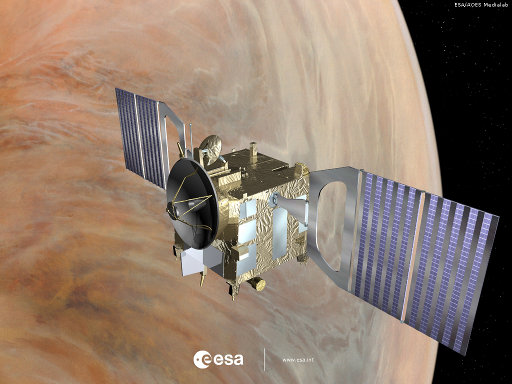
After nearly a month spent going in and out the upper layer of the atmosphere of Venus, at an altitude between 130 and 135 km (about 81 to 84 miles), in recent days the Venus Express spacecraft has started the series of maneuvers that will bring it up to around 460 km (about 286 miles) of altitude. It wasn’t certain that Venus Express could survive the harsh conditions that are found even at those altitudes but this success will allow the probe to make a few more detections before running out of fuel and finally falling to the planet.
The Venus Express spacecraft is an ESA project. Launched on November 9, 2005 on a Soyuz-FG/Fregat rocket and arrived into the orbit of Venus on April 11, 2006, over eight years it carried out studies on this planet. In particular, it allowed a prolonged observation of Venus’ atmosphere to better understand why on a planet in many ways very similar to the Earth some truly hellish conditions could be created.
The routine scientific operations of the Venus Express spacecraft were completed on May 15, 2014. At that point, since there was still some fuel available, the planning of an aerobraking maneuver started. It’s a technique that exploits the friction of a planet’s atmosphere to slow down a spacecraft. The consequence is the lowering of the orbit so it’s often used with satellites when it comes the time to make them fall to the ground.
In this case, the aim was to allow the Venus Express spacecraft to make some sort of surfing on the top layer of the atmosphere of Venus. In this way, it was possible to make direct measurements of its local density through the friction generated on the spacecraft.
Space missions to Venus have always been very difficult because of the atmosphere very thick and hot of the planet. In recent decades, some space probes landed on its surface but in the best cases were able to send data for a few hours before being put out of action by those terrible conditions.
The analysis of the conditions faced in the last month by the Venus Express spacecraft will allow to better plan future missions, perhaps not only to Venus but also to other extreme places. We don’t know exactly how long the spacecraft will take to run out of fuel and fall on Venus but these last weeks of life could be extremely useful.
[ad name=”eBayUSUKAstronomy”]


Permalink